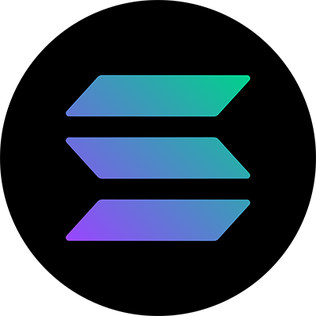Charts
About Solana
Solana: A High-Performance Blockchain
Solana: A Brief History and Overview
Founding and Development
Solana, a high-performance blockchain platform, was founded in 2017 by Anatoly Yakovenko, a former Qualcomm engineer with extensive experience in distributed systems and compression algorithms. Yakovenko’s vision was to create a blockchain that could address the scalability issues plaguing existing platforms like Bitcoin and Ethereum. He teamed up with Greg Fitzgerald and Stephen Akridge, who brought their expertise in operating systems and GPU optimization to the project. Together, they aimed to develop a blockchain capable of supporting high throughput and low latency transactions.

Initial Launch and Growth
Solana was officially launched in March 2020 after three years of rigorous development and testing. The project quickly gained traction in the crypto community due to its innovative approach to scalability. Solana’s mainnet beta went live with support for smart contracts and a focus on providing a robust infrastructure for decentralized applications (dApps).
Total Supply and Tokenomics
The native cryptocurrency of the Solana network is SOL. At its genesis, Solana had a total supply of 500 million SOL tokens. However, the actual circulating supply is dynamic due to factors like staking rewards and token burns. Solana’s inflation schedule and tokenomics are designed to incentivize network participation and maintain long-term stability. As of 2024, the circulating supply of SOL stands at approximately 400 million tokens, though this number can fluctuate based on network activity and economic mechanisms.
Major Stakeholders
Solana’s growth and development have attracted significant investment and support from major stakeholders in the blockchain and cryptocurrency industry. Some of the prominent stakeholders include:
- Solana Labs: The core development team behind Solana, responsible for its initial creation and ongoing technical advancements.
- Solana Foundation: A non-profit organization dedicated to the adoption, growth, and decentralization of the Solana network.
- Andreessen Horowitz (a16z): A leading venture capital firm that has invested heavily in Solana, providing both financial support and strategic guidance.
- Polychain Capital: Another major venture capital firm known for its investments in blockchain technology and cryptocurrencies.
- Coinbase Ventures: The investment arm of Coinbase, one of the largest cryptocurrency exchanges, which has also invested in Solana.
- Alameda Research: A quantitative trading firm and liquidity provider in the cryptocurrency markets, closely associated with FTX exchange, which has been a major supporter of Solana.
- Multicoin Capital: A crypto-focused investment firm that has been an early and active investor in Solana, contributing to its ecosystem development.
Technological Innovations
One of Solana’s key innovations is its consensus mechanism, known as Proof of History (PoH). This unique approach to consensus allows the network to order transactions in a verifiable and consistent manner without the need for a central clock. PoH works in tandem with Solana’s Proof of Stake (PoS) mechanism to secure the network and enable high throughput. This dual approach allows Solana to process thousands of transactions per second, significantly outpacing many other blockchain platforms.
Objectives and Vision
The primary objective of Solana is to provide a scalable, secure, and decentralized infrastructure for dApps and decentralized finance (DeFi) projects. Solana aims to support global-scale applications without sacrificing decentralization or security. Its architecture is designed to handle high throughput and low latency, making it an attractive platform for developers looking to build high-performance applications.
Adoption and Ecosystem
Since its launch, Solana has seen significant adoption across various sectors. The Solana ecosystem hosts a wide range of projects, including decentralized exchanges (DEXs), non-fungible tokens (NFTs), and DeFi platforms. Major projects like Serum, a high-speed DEX, and Star Atlas, a blockchain-based game, have chosen Solana for its performance capabilities.
| Event | Date | Details |
|---|---|---|
| Founding | 2017 | Anatoly Yakovenko, along with Greg Fitzgerald and Stephen Akridge, begins development of Solana. |
| Whitepaper Release | 2018 | Solana publishes its whitepaper, introducing Proof of History (PoH). |
| Mainnet Beta Launch | March 2020 | Solana’s mainnet beta goes live, supporting smart contracts and dApps. |
| Mainnet Launch | June 2021 | Solana transitions from beta to mainnet, marking a significant milestone. |
| Total Initial Supply | 2020 | 500 million SOL tokens |
| Circulating Supply | 2024 | Approximately 400 million SOL tokens (subject to change due to staking and burns) |
| High-Performance DEX (Serum) Launch | August 2020 | Serum, a high-speed decentralized exchange, launches on Solana. |
.
| Feature | Description |
|---|---|
| Symbol | SOL |
| Launched | March 2020 |
| Founders | Anatoly Yakovenko, Stefan Heidemann |
| Consensus Mechanism | Proof-of-Stake (PoS) |
| Supply | 488,400,000 (SOL) |
| Max Supply | Infinite |
| Transaction Speed | Up to 50,000 TPS |
| Use Cases | DeFi, NFTs, Smart Contracts, dApps |
| Website | Solana |
| Blockchain Explorer | Solana Explorer |
News
